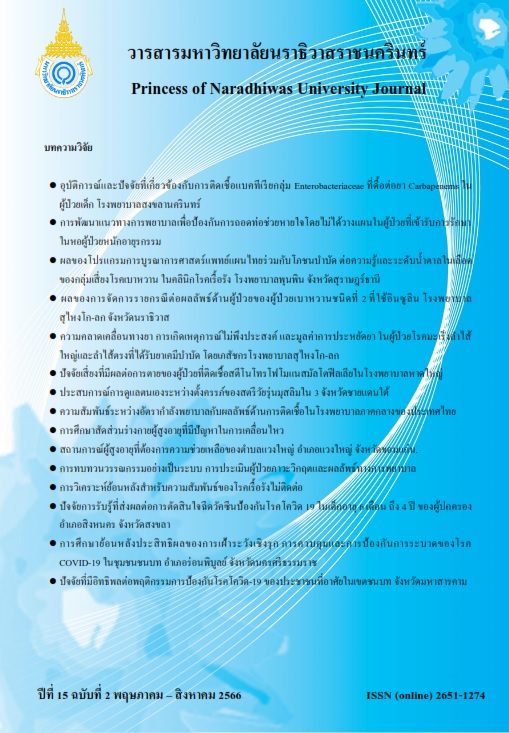ความสัมพันธ์ระหว่างอัตรากำลังพยาบาลกับผลลัพธ์ด้านการติดเชื้อในโรงพยาบาลภาคกลางของประเทศไทย
คำสำคัญ:
อัตรากำลังพยาบาล, ผลลัพธ์ด้านความปลอดภัย, การติดเชื้อในโรงพยาบาลบทคัดย่อ
การวิจัยนี้มีวัตถุประสงค์เพื่อศึกษาความสัมพันธ์ระหว่างอัตรากำลังพยาบาลกับการติดเชื้อในโรงพยาบาลได้แก่ การติดเชื้อทางเดินปัสสาวะในผู้ป่วยใส่สายสวนปัสสาวะ (CAUTI) การเกิดปอดอักเสบติดเชื้อในผู้ป่วยใส่เครื่องช่วยหายใจ (VAP) และการติดเชื้อในกระแสเลือดในผู้ป่วยใส่สายสวนหลอดเลือดดำส่วนกลาง (CLABSI) กลุ่มตัวอย่างคือ หอผู้ป่วยในของโรงพยาบาลศูนย์สังกัดกระทรวงสาธารณสุข กลุ่มสำนักงานป้องกันควบคุมโรคที่ 5 จำนวน 100 แห่ง เครื่องมือวิจัยคือ แบบสรุปอัตรากำลังพยาบาลและแบบบันทึกการติดเชื้อในโรงพยาบาล เก็บรวบรวมข้อมูลจากฐานข้อมูลของโรงพยาบาลและหน่วยงานที่เกี่ยวข้อง และวิเคราะห์ข้อมูลโดยใช้สถิติสัมประสิทธิ์สหสัมพันธ์ของ
สเปียร์แมน ผลการวิจัยพบว่า
1) จำนวนชั่วโมงการพยาบาลที่ผู้ป่วยได้รับต่อคนต่อวัน (NHPPD) เฉลี่ยเท่ากับ 7.15 (S.D.=5.31) จำนวนชั่วโมงการพยาบาลที่ผู้ป่วยต้องการต่อคนต่อวัน (Expected NHPPD) เฉลี่ยเท่ากับ 7.40 (S.D.=2.37) ชั่วโมงการพยาบาลที่ขาดแคลน (Short NHPPD) เฉลี่ยเท่ากับ 1.94 (S.D.=3.60)
2) ชั่วโมงการพยาบาลที่ผู้ป่วยไม่ได้รับตามเกณฑ์ต่อคนต่อวัน (Short NHPPD) มีความสัมพันธ์ทางบวกกับการติดเชื้อในโรงพยาบาลอย่างมีนัยสำคัญทางสถิติที่ระดับ .01 ทั้ง CAUTI, VAP และ CLABSI (r=.427, .287, .276, p<.01 ตามลำดับ)
3) ร้อยละของพยาบาลวิชาชีพ (Percent RN) มีความสัมพันธ์ทางบวกกับการติดเชื้อในโรงพยาบาลอย่างมีนัยสำคัญทางสถิติที่ระดับ .01 คือ CAUTI, VAP (r = .360, .384, p < .01 ตามลำดับ) และมีความสัมพันธ์ทางบวกกับ CLABSI อย่างมีนัยสำคัญทางสถิติที่ระดับ .05 (r = .249, p < .05)
4) ร้อยละของบุคลากรที่ไม่ใช่พยาบาลวิชาชีพ (Percent NonRN) มีความสัมพันธ์ทางลบกับ CAUTI, VAP และ CLABSI อย่างมีนัยสำคัญทางสถิติที่ระดับ .01 (r = .388, .358, .325, p < .01 ตามลำดับ)
เอกสารอ้างอิง
American Nurses Association (ANA). (1996). Nursing quality indicators: Definitions and implications: Patient safety nursing quality. Washington DC: Author.
American Nurses Association (ANA). (1999). Nursing-sensitive quality indicators for acute care setting and ANA’s Safety & Quality Initiative. Retrieved June 24, from http://www.nursing world.org/readroom /fssafety.html
Behnke, M., Aghdassi, S. J., Hansen, S., Diaz, L. A., Gastmeier, P., & Piening, B. (2017). The Prevalence of Nosocomial Infection and Antibiotic Use in German Hospitals. Deutsches Ärzteblatt International, 114, 851–857.
Bumrungsak , R., Watagulsin, P., Kasemsaisuwan, A., Tantilipikara, P., Samanmit, Y., & Sawanpanyalert, N. (2018). Surveillance for Healthcare-Associated Bloodstream Infections. Journal of the Department of Medical Services, 43(1), 125-130.
Cimiotti, J. P., Aiken, L. H., Sloan, D. M., & Wu, E. S. (2012). Nurse staffing, burnout, and health care-associated infection. American Journal of Infection Control, 40, 489-490.
Cho, E., Sloane, D. M., Kim, E., Kim, S., Choi, M., Yoo, Y., … Aiken, L. (2015). Effects of nurse staffing, work environments, and education on patient mortality: An observational study. International Journal of Nursing Studies, 52(2), 535–542.
Cohen, J. (1992). A power primer. Psychological Bulletin, 112, 155-159.
Donabedian, A. (1988). The quality of care: How can it be assessed? Journal of American Medical Association, 60, 1743-1748.
Donabedian, A. (1992). The role of outcomes in quality assessment and assurance. Quality Review Bulletin: Journal of Quality Improvement. 18, 356-360.
Indrawattana, N., & Vanaporn, M. (2015). Nosocomial infection. Journal of Medicine and Health Sciences, 22(1), 81-92.
Jansson, M. M., Syrjala, H. P., & Ala-Kokko, T. I. (2019). Association of nurse staffing and nursing workload with ventilator-associated pneumonia and mortality: a prospective, single-center cohort study. Journal of Hospital Infection, 101(3), 257–263.
Khan, H. A., Baig, F. K., & Mehboob, R. (2017). Nosocomial infections: Epidemiology, prevention, control and surveillance. Asian Pacific Journal of Tropical Biomedicine, 7(5), 478-482.
Khunthar, A. (2014). The impacts and solutions to nursing workforce shortage in Thailand. Journal of Nursing Science, 32(1), 81-90.
Lasater, K. B., Sloane, D. M., McHugh,M. D., Cimiotti, J. P., Riman, K. A., Martin, B., … Aiken, L. H. (2021). Evaluation of hospital nurse-to-patient staffing ratios and sepsis bundles on patient outcomes. American Journal of Infection Control, 49, 868-873.
Morioka, N., Okubo, S., Moriwaki, M., & Hayashida, K. (2022). Evidence of the association between nurse staffing levels and patient and nurse’s outcomes in acute care hospitals across Japan: A scoping review. Healthcare, 10, 1052.
Musy, S. N., Endrich, O., Leichtle, A. B., Griffiths, P., Nakas, C. T., & Simon, M. (2021). The association between nurse staffing and inpatient mortality: A shift-level retrospective longitudinal study. International Journal of Nursing Studies, 120, 1-9.
Park, J. I., Bliss, D. Z., Chih-Lin Chi, Delaney, C. W., & Westra, B. L. (2018). Factors Associated with Healthcare-Acquired Catheter-Associated Urinary Tract Infections: Analysis Using Multiple Data Sources and Data Mining Techniques. Journal of Wound, Ostomy & Continence Nursing, 45(2), 168–173.
Ramirez, M. S. (2018). Urinary Tract Infection: Cost Study. HOSPITAL TOPICS, 96(2), 42-46.
Sawaengdee, K., Jaichuen, W., & Daecha, N. (2019). Manpower Reform Plan and Health Mission of the Ministry of Public Health. Nonthaburi: Suetawan. (in Thai)
Sujijantararat, R. (2019). Nurse staffing and scheduling. In Sukadecha, R. & Sujijantararat, R. (Eds.). Nursing Administration. Nakorn-ratchasima: Somboon Publishing. (in Thai)
Sujijantararat, R., Booth, Z. R., & Davis, L. (2005). Nosocomial urinary tract infection: Nursing sensitive quality indicator in a Thai hospital. Journal of Nursing Care Quality, 20(2), 134-139.
Sujijantararat, R., Thepna, A., & Hankunasets, W. (2018). Nurse Staffing and Nosocomial Infection Outcome. Journal of Nursing, Siam University, 19(37), 6-21.
Suwannobol, N., Tapin, J., & Aanansawat, S. (2018). A Study of the Infection Situation, Preventive Actions and Infection Control in Hospitals, Northeastern Region. The Journal of Baromarajonani College of Nusing, Nakhonratchasima, 24(2), 78-95.
The Office of Disease Prevention and Control Region 5 Ratchaburi. (2022). Hospital Level A, S and M1. Department of Disease Control, Ministry of Public Health. (in Thai)
Thonggleeb, B. (2016). An analysis of nurse staffing according to nursing activities and time spent on patient care. Thai Journal of Nursing, 61(3), 52–59.
Van, T., Annis, A. M., Yosef, M., Robinson, C. H., Duffy, S. A., Li, Y. & Sales, A. (2020). Nurse staffing and healthcare-associated infections in a national healthcare system that implemented a nurse staffing directive: Multi-level interrupted time series analyses. International Journal of Nursing Studies, 104, N.PAG.
White, A. (2022). Unlicensed Assistive Personnel (UAPs) and Medication Administration. Nursing CE Central, Retrieved from https://nursingcecentral.com/unlicensed-assistive-personnel-uaps-and-medication-administration/
ไฟล์ประกอบ
เผยแพร่แล้ว
รูปแบบการอ้างอิง
ฉบับ
ประเภทบทความ
สัญญาอนุญาต
ลิขสิทธิ์ (c) 2023 วารสารมหาวิทยาลัยนราธิวาสราชนครินทร์

อนุญาตภายใต้เงื่อนไข Creative Commons Attribution-NonCommercial-NoDerivatives 4.0 International License.




